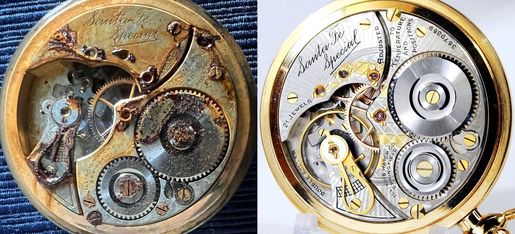

Welcome

The Seth Thomas Research website is the most accurate and comprehensive online resource for the factory's 29-year output of pocket watch production from 1885 to 1914, featuring:
- Serial number lookup and search returns for date, model, grade, and jewel count
- Over 40 charts for serial number blocks and production totals and percentages
- A separate page for each model to explore dates, run totals, and known variants
- An entire section devoted to private labels, sorted by name, dial, SN, and state
- Pages for factory dials, cases, period adverts, catalogs and surviving records
- A section describing the known patents, including links to the US Patent Office
- A Store for replacement parts by model, complete with the original factory number
The Latest Discoveries
Quick Reference

The Private Labels
The Private Labels
The Private Labels
Check to see if your great-grandfather was a jeweler, retailer, or store owner.

How They Work
The Private Labels
The Private Labels
Learn what went into your Seth Thomas, from dials and cases to factory patents.

Go Back In Time
The Private Labels
Go Back In Time
Find out about the man who started it all, including the timeline of the factory.
Data Submissions
Photographs of new examples are always needed.
If you have any watches or paper records in your collection then please share them with us.
Catalog prints and period ads will be posted to the Records page, and your watch will be logged on the appropriate chart, adding to the totals and making the search functions more accurate.
Pocket watch dial and movement photos only, please.
Need replacement parts?
Other Sources

There are no known surviving Seth Thomas records regarding pocket watch production, other than a few factory catalogs and period ads. This is verified both by the Historical Society in Thomaston, Connecticut, thanks to a bad flood there in 1955, and seven-times-grandson Seth R Thomas, who supplied the genealogical records back to James and Martha, parents of the original Seth Thomas in 1785, and confirmed that no one in the family has any surviving factory papers.
The sole extant publication concerning the pocket watch side of the Seth Thomas Clock Co is Chris Bailey's small 94-page booklet, printed in 1981, which is an invaluable resource containing period ads, part numbers, factory catalogs and more. There are eight additional volumes listed in the appendix, all of which are either out of print or lost. Multiple attempts have been made to follow up on these works - the Library of Congress, the Smithsonian Museum of American History Library, the NAWCC library, and rare book dealers have all been contacted - to no avail.
Included in the Bailey booklet is this two-page chart of serial numbers, separated by model alone and based on the 1904 catalog, ranging from SN 1 up to SN 1000000 - roughly half of the factory's eventual output. All of the models shown are either 6 or 18-size, with the sizes of 0, 12 and 16 evidently yet to come. Note that this simple chart shows no categories for jewel count, grade or variant, meaning that the only way that rough totals will become clear is by observation and cataloging surviving examples, which is what this site does. Nearly 11,000 examples have been logged here, barely enough to form a framework for overall production of the various models.
If any other giant online resource claims to know precisely how many of a given model or grade of Seth Thomas pocket watch was made, they are inventing those numbers literally out of thin air.
Plagiarism
This website has been plagiarized several times by those too lazy to do their own research, most notably by Nathan Moore, the rich owner of the PW Database. One can't help but notice how the PWBD's totals seem to mirror the totals on this site soon after it's updated. Attached are numbers for the Seth Thomas two-tone Grade 36 Model 8 so far according to logged examples, along with Nathan Moore's number, which appear strangely identical.
Considering that there are no other known records, where could have Nathan gotten his totals, if not this site?

Seth Thomas Research
The total of 33,150 two-tone Model 8s (pictured here) is a red herring, a deliberately wrong number put there to see if he would "borrow" it.

PW Database
And Nathan Moore did just that, inventing a similar total of 33,300. Perhaps someone could let Nathan know that stealing is wrong.

Have Yours Restored
Your vintage pocket watch can be put back to original factory specs with every part matching and correct.